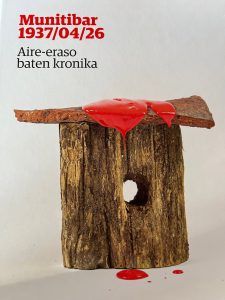I’ve written about how towns in the Basque Country besides Gernika were bombed during the Spanish Civil War. After lunch at the txoko, we went to the plaza in Munitibar to meet my dad’s sister Begoña, her husband Javier, and my dad’s sister-in-law Rosario. While we were there, Beñat Zabalbeaskoa Zabala, one of the town councilors of Muntibiar-Arbatzegi Gerrikaitz who I’ve met a few times before, grabbed me and took me to the udaletxea, the town hall. There, he gave me a copy of a book detailing the 1937 bombing of Munitibar by the Germans and Italians in support of Franco’s coup. I can’t do the book justice here – it is filled with first-hand testimonials of those that experienced that horrific day. I only wish I knew Basque better to more fully understand and appreciate what they went through.

- The book, entitled Munitibar 1937/04/26: Aire-eraso baten kronika (Chronicle of an Air Raid), collects testimonials from some 31 witnesses who were there on the day of the bombing on April 26, 1937, including my dad’s uncle, José Uberuaga Urionaguena. The book is broken up into several sections that detail the situation in Munitibar the days before the raid, the actual day of the raid, and the aftermath. It is illustrated with period photos, recreations, and maps that highlight where the bombs, some 25 at least, fell.
- Two days before the attack, the line holding the fascists at bay broke near Elgeta. This led to soldiers and civilians fleeing their advance. In particular, the Itxasalde battalion passed through Munitibar where soldiers were able to warn their families about what they feared would be an impending bombing. Indeed, bombs fell the day before the main attack of the town, in the surrounding forests, leaving craters that some witnesses called the size of a house. As soldiers fled from the front, reconnaissance planes tracked their movements and fed them to the advancing fascists.
- The towns of Arbatzegi and Gerrikaitz, today collectively known as Munitibar, were bombed on April 26. The Kamptgrupe K/88 squadron, comprised of Junkers Ju-52 bombers supported by Heinkel He-51 fighters and under the command of one Karl von Knauer, left Burgos in the morning, flying over Vitoria-Gasteiz and across the peak of Oiz as they made their way to Munitibar. The attack occurred in the morning, before noon as recalled by multiple testimonies, with bombs followed by machine guns strafing the ground. The squadron made several passes over the town during the day.
- Testimonies describe how people were in their fields plowing for beets or eating arroz con leche at lunch when the bombs fell. Others escaped to the woods, leaving older relatives who couldn’t easily flee behind in the baserri. The first bombs hit the Mataun baserri, right in front of the door, immediately killing 84 year old Justa Mendibe Arteach and wounding her son and granddaughter.
- Many of those present at the attack were families fleeing from other towns that had been attacked before. These families didn’t always have obvious places for shelter. Some hid under the bridge, which was an unfortunate choice as the bridge itself was bombed. Depending on the source, between 11 and 36 people were killed and many others seriously wounded during the day. Many houses and town buildings were damaged or destroyed. Craters littered the two towns and surrounding hillsides.
- The attacks on Munitibar ended some time around 3pm as the planes made their way to a new target: Gernika. Two days later, on April 28, the fascists occupied Munitibar.
Discover more from Buber's Basque Page
Subscribe to get the latest posts sent to your email.



Thank you again for all your great stories about Basque culture and history. I am wondering where I can buy this book about Muntibar. My wife’s grandfather (Juan Pedro Zarragoicoechea/Sarra) was from the house of Orueta in Arbatzegi. I would love to read about the experiences of the villagers and to find out if any of his relatives were included. I did not find a source to buy the book on Amazon or Google. Is there a local option for purchasing the book? I always look forward to reading your blog posts and the Maite & Kepa stories continue to be enjoyable. Keep up the great work!
Thanks Mitch! Iñigo just replied with more information about the book than I could ever give so I hope that helps you find a copy.
Hello Mitch.
This Book is published by a non-profit association “Ahaztuen Oroimena 1936”. The challenge is to compile the stories of Spanish civil war in the eastern area of Bizkaia (Munitibar, Aulesti, Markina, Etxebarria…). They have a very interesting website. https://ahaztuenoroimena.com/ (only in Basque language)
. I have seen it for sale in bars and some bookstore in the towns mentioned above. I am and live in Aulesti.
. Maybe by contacting the association through it website you can get the book.
. If you need more information do not hesitage to contact me. (loperena71@hotmail.com)
. Greetings
Iñigo Kareaga Urizar – Aulesti (Bizkaia)
Thanks for the information Iñigo! I hope this helps others find the book.